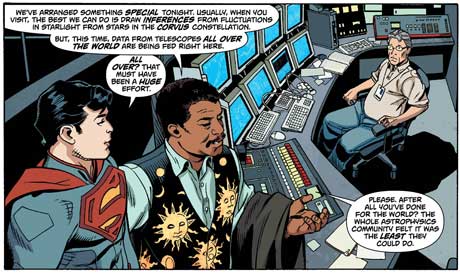
Having jumped ship from the Daily Planet, Superman has found his actual intergalactic home with a little help from a mere mortal, albeit a very brainy one.
Astrophysicist Dr Neil deGrasse Tyson will appear in a new Superman comic out Wednesday which reveals where Superman's home planet of Krypton is in our actual universe.
In the newest issue of DC Comics' Action Comics #14, Tyson helps Superman find his home planet of Krypton on the last day of its existence.
"As a native of Metropolis, I was delighted to help Superman, who has done so much for my city over all these years," Tyson said. "And it's clear that if he weren't a superhero he would have made quite an astrophysicist."
Tyson is famous for bringing science to a wider audience and was selected "sexiest astrophysicist" by People magazine in 2000. He is director of the Hayden planetarium in New York, which is where he meets with Superman in the new issue.
The comic book says Superman visits the planetarium every 382 days to see if he can get a glimpse of his home planet.
Superman was born on Krypton and sent to Earth by his father just before the planet was destroyed.
Dr Sholly Fisch wrote the new issue Star Light, Star Bright and has worked in educational media for more than 25 years. He said DC editor Will Moss suggested they reach out to Tyson who then offered to identify Krypton in the solar system.
Tyson found a few candidates in the actual universe before settling on a Krypton-like system that is located 27.1 light years from Earth and is slightly smaller and cooler than the sun.
Fisch said that being able to ground superhero science in the real world is a great storytelling device and can make the fantastic elements of comic books seem more real.
"If its against the backdrop of a world where anything can happen at anytime, it's not quite as special, but if you have a real grounding in the real world and have rules that you're following, then the fact that he can lift a mountain with one hand is much more striking," Fisch told the Guardian. "I think it helps with the suspension of disbelief and helps you to appreciate just how special the stuff he can really do is."
For those interested in finding the red dwarf star – and who have a very powerful telescope – DC Comics provided the coordinates of the star LHS 2520:
J2000
Right Ascension: 12 hours 10 minutes 5.77 seconds
Declination: -15 degrees 4 minutes 17.9 seconds
Proper Motion: 0.76 arcseconds per year, along 172.94 degrees from due north

